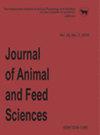Fluid and particle retention in the greater kudu (Tragelaphus strepsiceros)
IF 1.5
4区 农林科学
Q3 AGRICULTURE, DAIRY & ANIMAL SCIENCE
引用次数: 1
Abstract
. On the one hand, the greater kudu ( Tragelaphus strepsiceros ) is a strict browser and would therefore be expected to display a ‘moose-type’ digestive physiology with a comparatively low rumen fluid throughput, a low ratio of small particle to fluid mean retention time (MRT) in the reticulorumen (RR), and relatively unstratified RR contents. On the other hand, reports on relatively small salivary glands, susceptibility to negative effects of tannins, and a putative absence of tannin-binding salivary proteins would suggest the greater kudu to be an exceptional browser with a ‘cattle-type’ digestive physiology. We measured MRT in four zoo-kept greater kudu females, which resulted in a MRTparticleRR/MRTfluidRR ratio between 1.07–1.43, well within the range of ‘moose-type’ ruminants and similar to eland ( Taurotragus oryx ). In this regard, consistent morphophysiological studies on greater kudu are required to resolve the seemingly contradictory findings in this species.大羚羊(Tragelaphus strepsiceros)的液体和颗粒滞留
. 一方面,大kudu (Tragelaphus strepsiceros)是一个严格的浏览器,因此预计会表现出“驼鹿式”的消化生理,瘤胃液吞吐量相对较低,网状胃(RR)中小颗粒与液体平均滞留时间(MRT)的比例较低,并且相对无分层的RR含量。另一方面,关于相对较小的唾液腺,对单宁的负面影响的敏感性,以及推测缺乏单宁结合唾液蛋白的报道表明,大kudu是一种具有“牛型”消化生理的特殊浏览器。我们在四只动物园饲养的雌性大羚羊中测量了MRT,结果显示mrtpartir /MRTfluidRR比值在1.07-1.43之间,完全在“驼鹿型”反刍动物的范围内,与羚羊(牛头羚羊)相似。在这方面,需要对大羚羊进行一致的形态生理学研究,以解决这一物种中看似矛盾的发现。
本文章由计算机程序翻译,如有差异,请以英文原文为准。
求助全文
约1分钟内获得全文
求助全文
来源期刊

Journal of Animal and Feed Sciences
农林科学-奶制品与动物科学
CiteScore
2.10
自引率
0.00%
发文量
42
审稿时长
3 months
期刊介绍:
Journal of Animal and Feed Sciences (JAFS, J. Anim. Feed Sci.) has been published by the Kielanowski Institute of Animal Physiology and Nutrition, Polish Academy of Sciences in Jabłonna (Poland) since 1991. It is a continuation of the Polish-language journal Roczniki Nauk Rolniczych. Seria B, Zootechniczna published by the Polish Academy of Sciences since 1969.
JAFS is an international scientific journal published quarterly, about 40 papers per year including original papers, short communications and occasionally reviews. All papers are peer-reviewed and related to basic and applied researches in the field of animal breeding and genetics, physiology of nutrition, animal feeding, feed technology and food preservation. The journal distinguishes the multidisciplinary nature of physiological and nutritional sciences and so includes papers specialized in all fields connected with animal well-being, including molecular and cell biology and the emerging area of genetics.
 求助内容:
求助内容: 应助结果提醒方式:
应助结果提醒方式:


